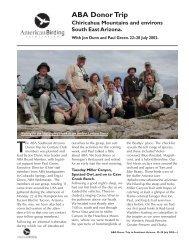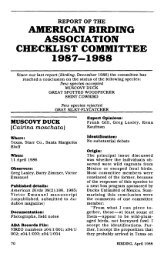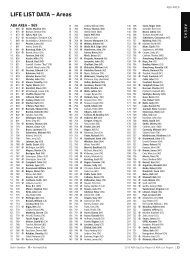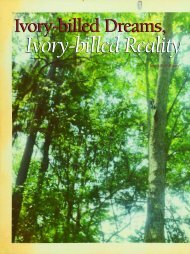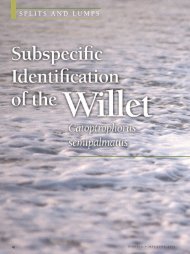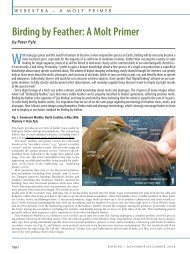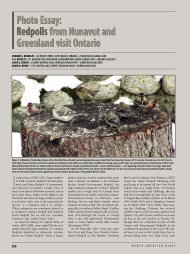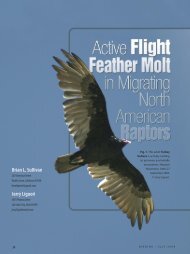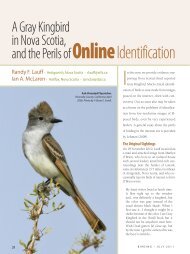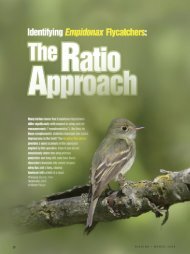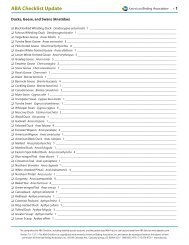2011 ABA Big Day & List Report - ABA Listing Central - American ...
2011 ABA Big Day & List Report - ABA Listing Central - American ...
2011 ABA Big Day & List Report - ABA Listing Central - American ...
- No tags were found...
Create successful ePaper yourself
Turn your PDF publications into a flip-book with our unique Google optimized e-Paper software.
we needed in 30 minutes and never spending more than 2 minutes on any one bird. A flybyBlue-winged Teal was the most unusual and surprising, although George had one onThursday. Almost back on schedule, we turned around at 17:00 at “Gadwall Bend” andheaded straight to the Pocomoke. A flyby Sharp-shinned Hawk was one of the biggestsurprises of the day. In the Pocomoke we had but 6 species to clean up, and despite anevening lull in birdsong, we managed to spish up or bump into Summer Tanager, KentuckyWarbler, Worm-eating Warbler, Brown-headed Nuthatch, Yellow-throated Warbler,and Pine Warbler between 18:00-18:18. Back on schedule suddenly, we turned north towardsOcean City hitting Snow Goose at Goody Hill Road pond (18:39), Ruddy Duck atBerlin W.T.P. (18:53), Glossy Ibis at Rte. 611 pond, a few shorebirds etc., but no PipingPlover at Eagle’s Nest flats (19:15-19:35), Little Blue Heron, Belted Kingfisher, and BlackpollWarbler (finally!) at West Ocean City Pond (19:43-19:55). We arrived late at Ocean CityInlet and barely scraped by with Red-throated Loon and Pacific Loon (20:05-20:20) beforeclosing the day at Skimmer Island (20:25-dusk). In the rapidly waning light we picked outfour 1st-winter Lesser Black-backed Gulls, a subadult Great Cormorant, and a couple TricoloredHerons dropping into the reeds. As the light waned to darkness, a last minutebrainstorm took us to 3rd Street in Ocean City where scoping of the back side of SkimmerIsland produced a small group of Brant, identifiable by their silhouettes against the water.At 201 species, we realized we were within shooting distance of the record of 206. Weneeded Chuck-will’s-widow, Eastern Screech-Owl, Whip-poor-will, Black Rail, King Rail,Least Bittern, White-throated Sparrow, Sedge Wren, Bicknell’s Thrush – all conceivablenocturnal species. At 21:00 we got Chuck-will’s-widow, Eastern Screech-Owl fell by 21:08,and with Whip-poor-will singing at 21:35 we thought we were on track. Alas, we decidedto bird southern Worcester and Somerset for the remaining species and none cooperated.The use of the boat was novel in Maryland <strong>Big</strong> <strong>Day</strong>s and was certainly worth the addedlogistical effort, if only for the thrill of planing across the flat calm Bay giving a welcomechange of pace at that mid-day point in a <strong>Big</strong> <strong>Day</strong> where your enthusiasm wanes and yourenergy disappears altogether. The species we added (scoters, Black Tern) were of higherquality than those we might have seen on a car crossing, and birding the Cambridge waterfrontwas good for several more good finds. The trip by boat is 1:30, about the sametime as a crossing by car. We could not bird the Poplar Island impoundments, but if wecould that could be included and might add some rarer shorebirds or additional ducks.Substitution of Elliott Island for Deal Island was unconventional but a recognition ofthe changes that have occurred at Deal. Where Pied-billed Grebe, Common Gallinule, andBlack-necked Stilt used to be guaranteed, and where <strong>American</strong> Coot and several additionalducks could be counted on, almost all have disappeared and we found NONE ofthe above in scouting efforts. Thus Elliott betters Deal, since Black-necked Stilt, Barn Owl,and Common Moorhen are all gettable, while only Peregrine Falcon is sacrificed. FutureMaryland <strong>Big</strong> <strong>Day</strong>s may mirror this route. We skipped Hurlock, since it had only SnowGoose and Ruddy Duck, both of which could be gotten elsewhere.Including Ocean City at dusk was spectacular, especially given the remarkable concentrationof gulls, cormorants, terns, and other birds at Skimmer Island. Unfortunately we ranout of time there and could have used an additional 15 minutes of light (8:10 to dusk) tofully cover the myriad birds on the flats. Our seawatch at Ocean City was also too late,since we suspect that Northern Gannet, which had been present in abundance during theprevious week (up until the previous day!) were not in evidence at 20:05-20:20. Future runsshould visit OC no later than 19:30 and should consider birding Ocean City Inlet, THENWest OC Pond, THEN Skimmer Island, THEN Eagle’s Nest.At West Ocean City Pond we were frustrated to FINALLY encounter some migrant warblers,obviously the result of a massive fallout which had hit coastal areas from Cape Mayto southern Virginia (hundreds of warblers on the Chesapeake Bridge-Tunnel). Our 5 minutesof birding only revealed to us that a large number of migrants were present – it didnot produce anything new for us except the Blackpoll Warbler.Finally, our route through Worcester and Somerset utterly failed with all our hoped fornocturnal species. We would have been better off cutting for Elliott at 21:30, where westood to gain Black Rail, King Rail, Least Bittern, and possibly something else like SedgeWren (found there by O’Brien et al. the previous night). While the route we chose couldproduce the same species, Elliott is probably more consistently good at night and hasmany more individuals of the species we sought. Perhaps on our next attempt we willhave refined the perfect route...?MARYLAND #4 – 25 August 01 – 0200 to 2330 – Species totals: 152/149 (Team/shared).Todd M. <strong>Day</strong> (150), Matt Hafner (152), Andrew Gilbert (150), Marshall J. Iliff (151). Milesby Car: 410. Miles by Foot: 2. Visiting: Vienna marshes, Assateague Island,Ocean City, Pocomoke River, Deal Island WMA, Hurlock Sewage Ponds, ElliottIsland, Easton Sewage Ponds. Species of Note: Black Rail (R), <strong>American</strong> Golden-Plover(R), Chuck-will’s-widow (L), Lark Sparrow (V), Sandwich Tern (M), EasternMeadowlark (M).Comments: On 25 Aug 2001 Todd <strong>Day</strong>, Matt Hafner, Andrew Gilbert, and I attemptedan August <strong>Big</strong> <strong>Day</strong> for Maryland. As there has been no previous such attempt in the state,we took solace in the fact that our efforts were certain to produce a new record. For a periodafter serious tiredness had long since set in, we stayed awake by rejoicing with shouts,yells, and beeps of the horn each time we beat the old record (i.e., added a new species).We left my house in Annapolis at 2:05 a.m., with Eastern Screech-Owl in the bag. Fromthere we headed to Marsh Road (Old Route 50) on the Nanticoke River, where the coolconditions left us rail-less. A loop along Colbourne Mill Road scored Barred Owl and welucked into a Great Horned Owl dining on an Opossum in the middle of the road. We arrivedat Bayside Campground a tad late at 6:25 a.m. Despite an impressive night flight,with hundreds of warblers and 20+ Veeries passing overhead, the dawn flight spectaclewas essentially nil (20 redstarts and 1 Prothonotary), so we birded the basics on Assateagueas quickly as possible and headed to Eagle’s Nest. A stakeout Lark Sparrow anda surprise roosting Chuck-will’s-widow were Assateague highlights. The flats at Eagle’sNest there did not disappoint, producing Piping Plover, Short-billed Dowitcher, and Dunlin,the only ones of those species for the day. Ocean City however, DID disappoint, as wefailed to find Sandwich Tern and several other key species.From there we hit West Ocean City Pond, Berlin Sewage Ponds, <strong>Central</strong> Landfill (oneLesser Black-back was enough), and headed to the Pocomoke River area for late breeders.Amazingly, Prothonotaries were present at 3 additional sites, and while we foundmost breeders still lingering, we missed Yellow-throated Warbler, Yellow-throated Vireo,Kentucky Warbler, Hooded Warbler, and not surprisingly, Louisiana Waterthrush. Wehoped for ducks and shorebirds at Deal Island, but only managed harrier, Gadwall, and acouple other species. Another few hours of searching for migrants cleaned up a few missingbreeders. Hurlock Sewage Ponds produced its regular few extras but missed BlackTern. More attempts at migrants were fruitless so it was on to Elliott Island. At Elliott wemanaged the few remaining species that we needed, except for Eastern Meadowlark. Aflyby Common Nighthawk at dusk was a slight bonus, but Barn Owls did not cooperate.We closed the night with a couple additional rails that put on a great show.Other than the Lark Sparrow that had been found a day earlier on Assateague by MarkHoffman, highlights included finding unexpected <strong>American</strong> Golden-Plovers at two locations,and enjoying a great Black Rail performance among mosquito swarms after dusk.In general, shorebird habitat was sub-par as well and Stilt and Western Sandpipers, usuallygetable, were nowhere to be found. Nonetheless, the camaraderie was great, thebread-and-butter birds were findable enough, and the conditions, while windy, were good.Eastern Meadowlark was the most embarrassing miss, but finding no Sandwich Terns atOcean City and no Black Terns at Hurlock were equally frustrating.Although a 1 Aug day that followed the May/June/July route from Garrett County tothe coast may produce a better total, we feel that our all-coastal migrant route would bemuch more fun than a route that drove twice as far, birded the coast less, and missed abunch of breeders in western Maryland as well as those on the coast. With a little betterluck with a couple tricky species and with ANY kind of migration, we might have pushedthe number up to 165 or so.MARYLAND #5 – 4 December 99 – 0300 to 1800 – Species totals: 130/124.(Team/shared). Marshall J. Iliff (128), Greg Miller (127), George M. Jett (124). Miles byCar: 200. Miles by Foot: 1. Visiting: Irish Grove, Vessey Orchard, Hickory Pt., Ocean City,Ironshire Station Rd., Berlin, Furnacetown, Deal Island. Species of Note: White-wingedScoter (M), Common Goldeneye (M), Peregrine Falcon (M), <strong>American</strong> Woodcock (M),Lesser Black-backed Gull (M), Eastern Screech-Owl (M), Barred Owl (M), Tree Swallow(M), Horned Lark (M), Pine Warbler (M), Palm Warbler (L), Le Conte’s Sparrow (V), SeasideSparrow (L).Comments: The 4 December <strong>Big</strong> <strong>Day</strong> was run by Greg Miller, George Jett and MarshallIliff. We did not go as crazy as we might have, and elected to sleep in rather than bustour butts trying to get owls. The 3:00 meeting time at the west end of the Bay Bridge leftlittle time to get the easy ones (Screech and Barred were missed) and no time for the funones (Long-eared, Saw-whet). I saw the Mute Swans in the Bay Bridge pond on the wayacross but the others missed them and we had not officially started by <strong>Big</strong> <strong>Day</strong> rules (sincewe were in two vehicles).Mark Hoffman pointed out last January (in response to my needling him) that tapes areallowed so in contrast to our tape-free January (135) and March (136) big days, we playeda bit of EASO (screech-owl) tape. Did not make up for the lack of scouting and we finishedbelow both of those attempts, though theoretically the earlier date should have helped incompetition with January, though the latter <strong>Big</strong> <strong>Day</strong> benefits from CBC intel.The basic route was as follows: predawn stop at Dividing Creek (missed Barred Owl),Irish Grove for dawn and an hour thereafter, Vessey Orchard (missed Vesper Sparrow, gotPalm Warbler), Pocomoke City, Hickory Pt., OC Inlet, Skimmer Island, West Ocean CityPond, West Ocean City (Hooper’s=Skimmer Island), Eagle’s Nest Campground mudflats,Evans Rd., Ironshire Rd., Berlin Ross’s Goose spot, Furnacetown (by which point we wereterribly behind schedule - time was 4:00), Chance, Deal Island (late arrival was costly),<strong>2011</strong> <strong>ABA</strong> <strong>Big</strong> <strong>Day</strong> <strong>Report</strong> & <strong>ABA</strong> <strong>List</strong> <strong>Report</strong> | 13



